The Marston/Peter Wonder Woman roundtable index is here.
________________
I’m not a fan of the superhero genre in general, and, while I do own a volume of the Marston & Peter run of Wonder Woman (henceforth WW), I find I enjoy reading Noah’s posts on the series more than reading the series itself. That’s not a bad thing, I guess, good criticism should increase our enjoyment of a work, right? (And now I’ve set myself up for failure.) So why am I participating in this roundtable: there’s something about I love about Harry Peter’s style. But what does that even mean? What is style in a comic: how do we talk about it, and what is distinctive about Peter’s that appeals to me? That is what I am going to try to address. We’ll see how it goes, as this post is as much an investigative process for me as it is any kind of coherent result. Let’s consider it a kind of close reading.
What constitutes the (visual) style of a comic, and more specifically how can we address the individual’s style? There is surprisingly little written about this subject in regards to comics (or else, I’m just not finding it, suggestions in the comments please). Harvey, in his Art of the Comic Book, lists style as one of the four “distinct graphic threads”, yet punts on the issue saying its “storytelling role” is “too subtle for much elaboration here.” (9-10) McCloud addresses style in Understanding Comics in the form of his big triangle and his charts of panel transitions, but he tends to generalize his discussion into broader groups and effects (and the placement of artists on that triangle often seems pretty random). Wolk writes about style in a very broad way when comparing the “mainstream” to “art” comics, but his discussion tends to over-generalize to make his point. Groensteen offers a decent introduction to comics style in his La Bande Dessinée: Mode d’Emploi, pointing out the inclusion of elements other than just the drawing/inking/coloring in the style of comics and comparing a few different artist’s styles, but it’s an introductory book so he doesn’t go into a lot of detail.
Style in comics is more than just line, tone, color, composition, and the way the images are drawn (realistic, caricatural, detailed, minimal, etc.), it is also the page layout, the découpage (“narrative breakdown” is what Harvey calls it, but I feel that the French word is less specific to narrative comics–not to be confused with shellacking paper onto boxes). All these elements work together to give the comic its style (one could, depending on the work and its context, add other elements, but for the purposes of a comic book like WW, this should do). For a single author work it is easy to attribute all these factors to the stylistic of the author, but this attribution is more difficult for the corporate comics structure that Peter worked in for WW.
Page layout, découpage, and perhaps composition can be partially or wholly attributable to the writer. Some comics writers write detailed scripts breaking down the narrative into panels, pages, even describing specific images and compositions (I’m looking at you, Alan Moore). Without seeing a script it is hard to ascertain this level of credit. Similarly, many of these comics are inked by a different artist than the one who pencilled the images. How can we then attribute the visual style of line, tone, detail? The inker could faithfully or loosely follow the pencils; the inker can add or leave out details; the inker can exaggerate or tone down the penciller’s figures. (Probably the most prominent place to see this addressed in discussions concerns the various inkers of Kirby’s work, though I’ve found it relevant in looking at Toth’s work also.) Color can also be wholly or partially attributable to hands other than the artist. Most corporate comics are colored by someone else (nameless in the days of Peter’s work), and who picked the colors is not always clear. It seems to have been common that newspaper strip artists provided color guides, but I believe that would be unusual for comic books at the time of this work.
The Grand Comics Database credits Peter did his own inks on WW, though Nadel notes that he was “aided by a number of usually female assistant” (28). This calls into question how much of the pencilling and inking we can consider “his.” But for the purposes of this post, I must assume that Marston gets credit for the story and text as well as at least some credit for the découpage, and Peter gets credit for everything else except the coloring (maybe the lettering, but I’m not concerned about that). Much of this is supposition on my part as I have not seen one of Marston’s scripts, and I don’t know the historical details of who did what. These basic assumptions give me some limitations to work within. I’ll start at the broader level and move towards the specific. For better analytical purposes, I will be discussing both issue 28 (Mar/Apr 1948) and issue 3 (Feb/March 1943). Images will be cited as ISSUE: PAGE.PANEL where I am using the page numbers on the art itself (in both cases consisting of a number and a letter (for the parts of the issue)): so the fourth panel on page 2 of issue 28 is “28: 2A.4.”
Page Layout
At first there appears to be nothing unusual or stylistically distinct to note about Peter’s page layouts. Other than the splash pages, every page in Issue 3 has 3 horizontal strips, each divided into 2 or 3 panels (6-8 panels per page). With only 2 exceptions (3: 7B,9B) every page is based on the 9 panel conventional grid layout. Even the splash pages have the single small panel that is basically 1 panel from a 9 panel grid.
Issue 28, 5 years later, shows some development in Peter’s layouts. The splash pages are now just single images. All but two of the remaining pages have between 5 and 7 panels, still quite conventional. Most are still based on a 9 panel grid, but he varies some of the panels in size to fit the composition/content: tall panels for dramatic full body images or vertically-based action, wide panels for large groups or horizontally-based action. The pages are still primarily formed out of three horizontal strips of 1 to 3 panels each, but a number of pages are formed of two strips, most often in what Chavanne calls a “fragmented” layout. For instance on page 3A the top strip starts with one tall panel (a focus on full figures) followed by two stacked panels (horizontally-based action). (For an example see the full page image in the composition section below.)
This use of the fragmented layout is not unusual to contemporary readers, as it is, at this point, a convention. I didn’t think much of it either in the context of Peter’s work until I started looking at other comics I had on hand from the time period (or a bit later, I don’t have many comics from the late 40s). Tarzan No.2 drawn by Jesse Marsh, also dated March/April 1948, proves to be even more conventional with all but 2 pages having 6 panels (3 strips, two panels each). The first three comics (drawn by Lily Renée, Matt Baker, and Warren King) dated in 1949 from Romance Without Tears all have pages with 3 strips and 6-7 panels each. The first few stories in Krigstein: Comics from 1949 also show no use of the fragmented layout. Peter’s own Man o’ Metal comic (found in Nadel) includes a couple uses of the fragmented layout, though I notice that each time it’s used Peter has included little arrows to direct the reading path. This is an another indicator that this particular type of layout has not become convention. So perhaps Peter’s layouts, with the use of these fragmented layouts, are a little more unusual for the times than I thought, though I still don’t think we can consider them a distinctive stylistic element.
More subjectively, it’s hard to say that anything about the layouts are expressive. They are mostly invisible, in the sense that unless you really look at them, they go by unnoticed. They just serve the narrative neutrally, panels placed into the page to fit the content and keep the narrative continuing smoothly. Of course, dividing the page in these ways is also the simplest from a production standpoint, which is important when you’re trying to draw a lot of pages on a schedule.
Panel Composition
Like most comics (especially at the time), characters/figures are the primary focus of the compositions. I count 8 (issue 3) and 6 (issue 28) images that are (arguably) not focused on a character or group of characters, and only 3 and 1, respectively, of those have no figures at all (it’s the monkey changed into a “prehistoric tree fox,” in issue 28 in case you’re wondering). That said, Peter does not neglect the backgrounds (since the figures are the focus, I feel safe calling everything else the “background”). He creates and maintains a sense of the settings, only occasionally eschewing any background at all, usually in cases of crowded figure groups (28: 7A.2), close-ups, and panels with lots of text.
On the whole he uses, to apply filmic terminology, medium and long shots for his compositions. Most of the scenes show the characters at a consistent size (where we can see full or almost full figures) across panels. Peter rarely uses close-ups: a few heads tightly framed with word or thought balloons, and one notable close-up of Eviless’s hand as she surreptitiously steals WW’s lasso (28: 4A.1). This last unusual panel is fittingly also a key narrative turn in the story (without it we really wouldn’t have the rest of the plot). Issue 3 has two close-ups of textual content (a letter and a news story) but otherwise is similar.
Dramatic angles (high or low) are almost never used in these two issues. The view of the characters stays at eye level and shifts only for action that almost requires a high or low angle (28: 10B-11B) or for longshots that show more of the setting.
Peter maintains a surprising sense of depth throughout issue 28. It’s not an extreme depth, we rarely see anything large and close cropped in the foreground, but all the non-close-up images at least retain some semblance of depth: groups of characters shown in deeper space or background elements placing the characters into space. The panels in Issue 3 are less deep as he used a lot of sharp, angular planes in the background that flatten the space (3: 8B.4 is a good example of an outdoor scene).
Many of the compositions in issue 28 have a strong forward (that is, to the right) motion. WW’s (and the other characters’) actions tend to direct her to the right (8A, 11A, 10B, 3C). An exception to this are the chaotic fight scenes that punctuate the story (6B-7B are a good example) where the chaos is emphasized by the composition losing that forward motion. I think this element is one of the highlight of Peter’s style and what makes his style effective for this type of action comic. Notice how everything moves forward/right in the following page with the except of the three central figures (panel 4) how are fighting against WW (also here is one of those fragmented layouts).
Figures
For many people the way figures are drawn is the key index of an comic artist’s style. Since comics are so figure-based it becomes natural that artists can be identified solely by their figure work. In common parlance the “style” of an artist is often used to mean the way their imagery is, or is not, in accordance with ideas of the “realistic.” The “photorealist” style of artists like Alex Raymond, Stan Drake, or Neal Adams as compared to a cartoon/caricatural style of Schulz, Barks, or Segar. This usage of “style” tends to come down to the way the figures (and objects) are shown to be close (or far) from “reality” as far as proportions, shape, and detail, as well as to the actual rendering of line and tone.
I’d rather not attempt to unpack these concepts here, except to note how Peter fits into these general conceptions. Peter’s figures are certainly naturalistic in many ways. They generally have “normal” proportions and move in natural ways (both the bodies and the faces) (a key exception here is Etta Candy, who is far more caricatural). Where the proportions are abnormal is where Peter starts to be distinguished. His characters are large in the shoulders and head, while hips, waist, and legs tend to be much narrower. He also draws men differently than woman, which is so befitting of this series one wonders how much it is a general aspect of his style and how much it is something he took on for the series. His male characters (which are very few in issue 28 and not much more plentiful in issue 3) have really outsized heads and shoulders, with angular, blocky faces with prominent cheeks, jaws, and foreheads. All of which often renders them bit grotesque. Steve Trevor is one weird looking dude (28: 10A.5, below). Peter’s women tend to be more glamour girl-ish, a gender distinction which is not unprecedented in comics. Cliff Sterritt’s Polly and Her Pals featured Polly as a stylish glamour girl while her parents were caricatured figures. The eyebrows on Peter’s woman are also quite pronounced and arced, in a way that is reminiscent of Caniff, while their eyes are often enlarged (more so in issue 28).
Peter’s figures have a strong sense of movement and dynamism to them in Issue 28. His generally curved line adds to this effect as does the way his figures curl in upon themselves. Even in action WW’s legs and arms are often bent in towards her body (leaping with legs bent in at the knee). One could almost read that as working in conjunction with Marston’s bondage themes. The characters’ actions are both freeing and restricted.
I note in comparing issues 3 and 28 that the figures in issue 3 are stiffer, a bit more awkward looking, while in issue 28 they are softer, more rounded. Another example of Peter’s evolving drawing style, though also potentially an effect of changing assistants. Personally, I find the earlier work more distinctive if considerably more rudimentary looking from a pure figure drawing point of view.
Line
Peter’s line work is one thing that really attracted me to his work when I first saw it. There was something vibrant about his lines and the way they curved and bled together that was so unusual in the early issues I read. Issue 28 is a disappointment in this regards. Peter’s inking seems to me really conventional for the issue, though it is technically competent. He has a pretty consistent line weight that tapers at the ends and thickens on the curve and to emphasis volume and shadow (a nib pen, clearly). His characters are drawn with a line that is mostly consistent to that used on the backgrounds. His blacks (most notable in this issue on the some of the villains’ clothing and on the bodies of the half-ape people) tend to be a little messy looking, a conglomeration of feathered strokes. He doesn’t make much use of pattern or texture, with the exception of costuming (stars, leopard spots, prison stripes), and the occasional banal brick pattern. The work does not show the flair that makes you really notice and appreciate him solely for the way he used a pen or brush.
Much of the above seems to work against the distinctive aspects of Peter’s style. In so many ways, his work in these issues seems so conventional for the context. Or perhaps I am missing some aspects by ignoring the color and the découpage or all the other aspects of comics I haven’t even addressed. On the whole Peter is not what you’d call an innovator: he’s not pushing the form, nor is his art particularly ostentatious.
The Idiographic
I steal this usage from Charles Hatfield’s Hand of Fire to label the distinctive aspects of an artist’s style, those that work as signs to identify that particular artist. We might say that it is a combination of all these factors (and more that I’ve surely missed) which work together as a kind of networked sign of “style,” but I think we can draw out certain aspects that veer away from the conventional aspects of the work and those indistinct aspects which were/are shared with many other artists. There is a certain amount of subjectivity to this endeavor. These are the parts of his work that I see as distinct.
The older issues of the series (like issue 3) have this scribbly, curly-cue line that is really distinctive, used in clouds and hair and foliage. The early issue also seems to be more curvy in general, where the folds in clothes, muscles and visible bone structure (knees, clavicles, shoulder blades), and flanks of animals all have a distinctive curve to them. That little bit of excess seems stripped out in issue 28. Is this just a result of Peter changing his style, becoming a little more conventional? Or is this a result of changing assistants (or adding assistants since those early issues)? It is a good reminder that style is variable over time.
I’m particularly enamored of the clouds and puffs of smoke or gas that pepper the series (3: 6D.7; 3: 12A.4):
Or these gowns with their thick, swirling curves (3: 6A.5-6):
Another aspect that stands out is Peter’s drawings of the materially insubstantial–the flames and power rays–and the non-diegetic (I struggle here for the right term, the elements that are not actually there in the story world)–the motion lines and thought waves. Below is great example with the licks of flame and the “blue hypnotic ray” (28: 11B.4):
Or these panels (28: 2C.5-6) with the flames, the wavy black lines of smoke or shadow, and the little glow around the sword WW carries. The curly hair in those two panels are also very Peter to me.
The next page (28: 3C.1-4) offers some great Peter motion lines that add such dynamism to the panels (and often counteract the stiff figures in bondage).
I don’t even know what this little pink puff is (some kind of Paradise Island foliage?), but I love it (3: 10A.2):
In comparing my “Archive Edition” volume with scans from the original comics (below: the top image is page 102 from the Archive volume, the second is the original), I can also see another factor that affects how one reads a style, the reproduction. The archive edition has a thicker line to it, which causes some of the tighter line work to bleed together. Some may cry foul at that, the scans and printing have changed the work, but I actually like Peter’s work that way (the updated colors are another story). The drawing takes on a bit of a woodcut flair to it because the black becomes more prominent and denser on the page. Am I perhaps then a fan of a Peter that never existed, a creation of modern reproductions, an artist in my own mind?
References
Benson, John, ed. Romance Without Tears. Fantagraphics, 2003.
Chavanne, Renaud. Composition de la Bande Dessinée. Éditions PLG, 2010.
Groensteen, Thierry. La Bande Dessinée: Mode d’Emploi. Les Impressions Nouvelles, 2007.
Hatfield, Charles. Hand of Fire: The Comics Art of Jack Kirby. U Mississippi, 2012.
Harvey, Robert C. Art of the Comic Book. U Mississippi, 1996.
Marsh, Jesse, and Gaylord DuBois. Edgar Rice Burroughs’ Tarzan: The Jesse Marsh Years. Dark Horse, 2009.
Marston, William and Harry Peter. Wonder Woman No. 3. DC Comics, 194
–. Wonder Woman No. 28. DC Comics, 1948.
–. Wonder Woman Archive Edition v.2. DC Comics, 2000.
McCloud, Scott. Understanding Comics. HarperPerennial, 1994.
Nadel, Dan, ed. Art in Time: Unknown Comic Book Adventures, 1940-1980. Abrams ComicArts, 2010.
Sadowski, Greg, ed. B. Krigstein Comics. Fantagraphics, 2004.
Wolk, Douglas. Reading Comics: How Graphic Novels Work and What They Mean. Da Capo Press, 2007.
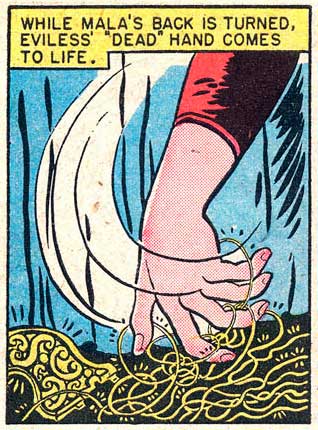
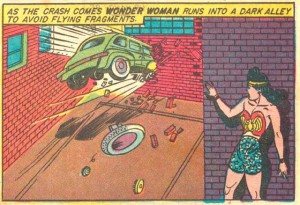
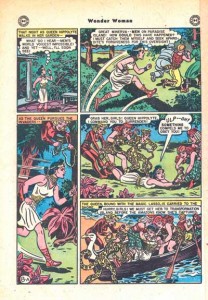
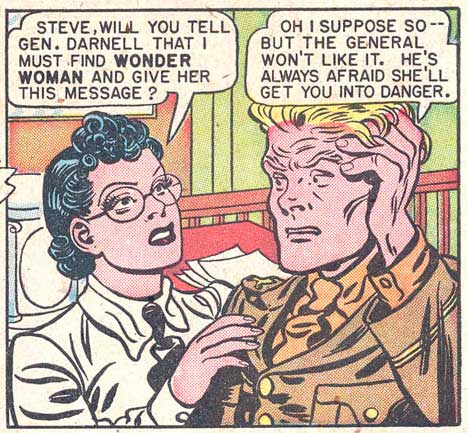

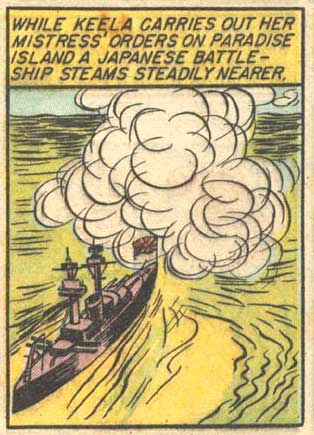
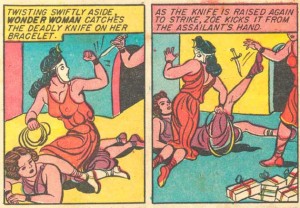
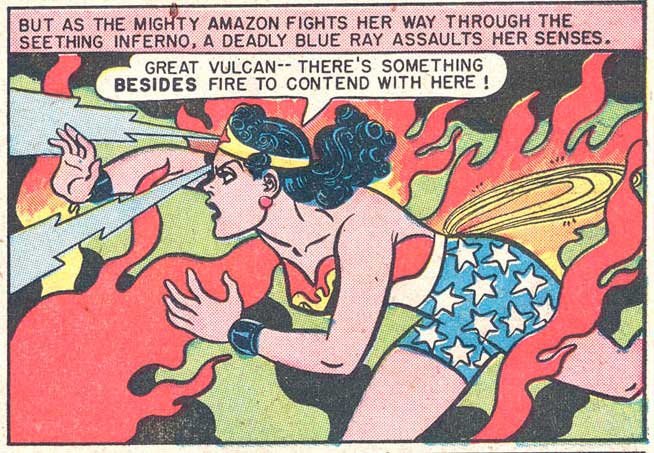

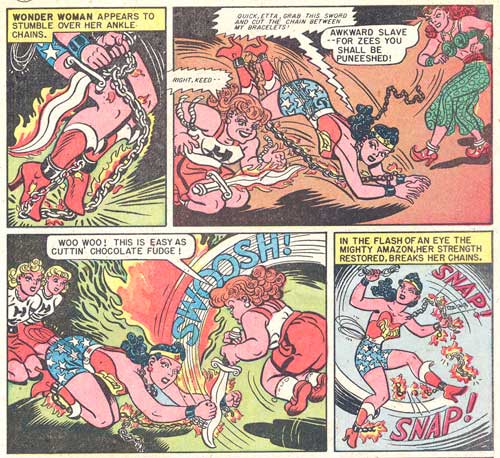


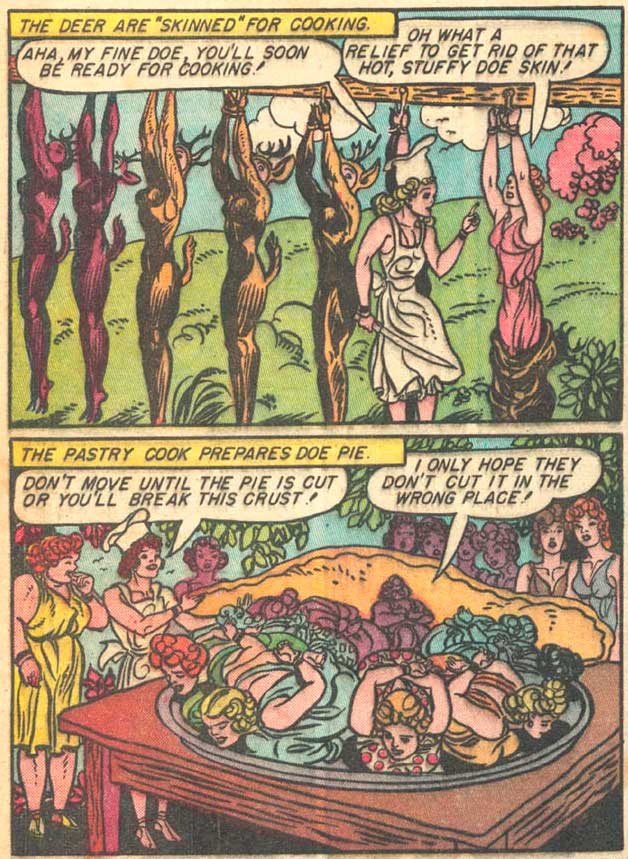
I’m pretty sure the pink puff is supposed to be a bush or something, as you guess.
This is a great post, by the way. You touched on a lot of things I’d noticed (the fluidity of the motion lines vs. the stiffness of the figures; the great eyebrows, the scribbles) and a lot of others I hadn’t really thought about (the way the men are so bizarre looking, the change in style from the early issues.)
As you point out, the layouts loosen up a lot over the run…and sort of along with that, Marston gets a lot less wordy, so there are even a couple of wordless action sequences (I think the first is in #16.) I think you’re right that it’s unlikely that this sort of thing is exactly innovative (it’s not Will Eisner), but they are very nicely done,and I think show a more conscious level of artistry certainly than a lot of superhero comics at the time.
You really didn’t notice the weird men? I thought that was an obvious one. Trevor’s no hunk.
Pingback: Madinkbeard | Derik Badman » 2012-05-14
I noticed it in bits and pieces, but never quite generalized. What can I tell you? Sometimes you (or I in this case) miss the obvious….
I guess you were too busy studying the psychosexual (not-so)subtext.
Great stuff, Derik! Really informative; lots of intriguing connections.
Thanks, Charles. Means a lot coming from you. I hope I used “idiographic” correctly.
Really nice; vive la formalisme.
On layouts: my own impression of early superhero comics is that it takes them a surprisingly long time to settle into the convention of regular grids. They’re often much more haphazard and, if I understand the term, fragmented.
It’s surprising given that you’d assume the artists were modelling their work on adventure newspaper strips, and most of those are relentlessly gridded. Maybe it’s that the artists aren’t, by and large, good enough to figure out how to express the information they want through regular grids?
As I mentioned in the post, I don’t have a lot of early comic books at hand, and I was too lazy to start trolling the Digital Comics Museum for examples. I too would assume the strip model would serve as an example, but I can see a more chaotic approach would occur. If you ever look at people who are new to comics making them, they will often layout pages without much concern for the overall coherence. You start at panel 1, put what you need there (and make it big enough to fit) and then keep filling in as necessity or one’s own fancy dictates.
The early Action/Superman comics actually number ever single panel in the issue….from 1 to 146 or whatever. The numbers are in these little (but increasingly larger) circles. Funny and weird.
Enjoyed it Derik
I still haven’t read Charles’ book, but if I understand the concept of the ideographic as you explain it above I don’t think that there’s any need to reinvent the wheel. “The ideographic” are just stylemes.
My favorite definition of style. According to Giles DEleuze, Peter is not a great stylist.
The comparison between the first version and DC’s Archive treatment is telling: ugh!!!…
Eh, what does Deleuze know. He thinks Sacher-Masoch is a genius.
Though for just that reason, I bet Deleuze would have been quite enthusiastic about the Marston/Peter WW.
Not that I dislike Deleuze. Or Sacher-Masoch, for that matter.
Sorry, Domingos, my French comprehension is not good enough to follow that video. Did Deleuze write on that somewhere? Haven’t read much of him, though I have his book on Bacon (on your recommendation I believe) around here (hard drive) somewhere. Haven’t read it yet.
Did find this (by Berel Lang from “The Concept of Style”) on “styleme” in a Google Books search: http://screencast.com/t/gTft80cb
Deleuze did write a bit about style here, mainly he quotes Proust saying that great literature is always written in a kind of foreign language. He also says that great stylists invent their own syntax reaching a kind of language limit.
I would agree in that respect (and many others) Peter is not a great stylist. Which wasn’t something I was arguing anyway.
So basically it’s an idealization of the avant garde…which is where I guess you’d expect Deleuze to be coming from.
I think it’s interesting to think about what Marston/Peter are doing in terms of the avant garde — but as a contrast. You can certainly criticize the comic as not living up to avant garde aesthetic standards — but I think it challenges those standards in some fairly interesting ways. Most notably, Marston/Peter are a lot more open to, and a lot more positive about, alternate sexualities and sexual expressions, not to mention feminism, than were a lot of avant garde artists of their time.
Peter’s style is I think both old fashioned and (comfortingly) sensual. An avant garde style that was deliberately disruptive or (even conceptually) virtuosic would have been pretty thoroughly out of place, it seems like.
I’m curious what you think about the Marston/Peter WW Domingos. Do you find it at all appealing? Or does it just seem like hackwork to you?
I have no opinion because I never read any Marston / Peter Wonder Woman comic, but I tried to read that WW comic strip Mike Hunter (it was Mike Hunter, right?) linked to and I couldn’t. I have no patience whatsoever for trash and I have no patience for inverted trash either (it’s still trash in my book). As for great stylists, I can see the appeal, but style isn’t the only criterion to judge a work of art. If I remember correctly Alberto Breccia, who, by the way, was a great stylist, was against style because he viewed style as a bunch of mannerisms. I don’t agree exactly (and Deleuze was intelligent enough – news flash! – to answer the criticism before it was formulated), but I understand why someone would say such a thing…
Inverted trash? I’m not sure I’m following you; could you elaborate?
I also wonder why it’s trash in the first place exactly. It doesn’t seem to fit most of the other reasons you dislike superhero comics. It’s not fascist (Marston is explicitly against not just fascism but violence itself.) It’s politically extremely progressive, at least as far as women’s issues go (there are problems with racism, but they’re certainly nowhere near as central to the comic as in McCay or Eisner or many other creators from the period.) It’s very ideologically conscious, and even sophisticated — it’s definitely not just hackwork without a point of view. Soooo…wherein is the trashiness, in your view? It can’t be the sexual content, can it? Or can it?
As I say above I have no opinion because I never read any Marston / Peter Wonder Woman comic. The anti-trash thing in the comic strip I tried to read is like antimatter: the electron is a positron and the proton is an antiproton, but both are still particles. The Fascism isn’t the only thing that bothers me in (most) super-hero comics, I’m also bothered by stupid Manichean plots and cardboard characters. The fact that there’s a man in distress rescued by a woman instead of the opposite situation doesn’t magically turn the comic into a good comic.
—————————-
Domingos Isabelinho says:
…I tried to read that WW comic strip Mike Hunter (it was Mike Hunter, right?) linked to…
—————————-
Yup, that was me! Sorry for the torture…
—————————–
…If I remember correctly Alberto Breccia, who, by the way, was a great stylist, was against style because he viewed style as a bunch of mannerisms. I don’t agree exactly…but I understand why someone would say such a thing…
——————————–
I can understand overvaluing style; but certainly for artists like Grunewald, Van Gogh, Beckman, Bacon their rendering approach is utterly necessary for what they want to get across…
——————————-
Noah Berlatsky says:
…I also wonder why [the Marston/Peter WW] is trash in the first place exactly. It doesn’t seem to fit most of the other reasons you dislike superhero comics…
——————————-
Oh, if Domingos were ever to admit a superhero comic had any worth whatsoever, his überelitist title would be revoked; this would happen: http://www.issues.cc/uploads/72869043991.jpg …
Understand why someone would be against overvaluing style, that is…
Aaah, I see.
I would say that the plots really aren’t Manichean. The villains are constantly flipping over into good guys, and dominance keeps turning into submission and vice versa. When there are actually thoroughly evil characters, they tend to be connected pretty strongly to gender politics; they’re rapists basically, and a strong anti-rape message in 1942 strikes me as fairly thoughtful. (I don’t see Susan Brownmiller’s Against Our Will as being Manichean, for example.)
Cardboard characters…it’s definitely not about realism, I’ll agree with that. The depth is in the working through of the ideas, not in creating fully rounded or believable people. It’s allegorical more than it is naturalistic. That doesn’t put me off, but if it does you then yeah, probably not the comic for you.
We can never say never, right? Maybe some underdeveloped characters in some weird Tsuge story aren’t so bad, but I view that kind of thing more as poetry than prose. What really bothers me is that good vs. evil shit. Also: Peter’s drawings don’t do much for me at all.
Mike: “I can understand overvaluing style; but certainly for artists like Grunewald, Van Gogh, Beckman, Bacon their rendering approach is utterly necessary for what they want to get across…
Deleuze’s point exactly.
I love the drawings…but that is me.
I think the good vs. evil themes in Marston/Peter are fairly complicated, or at least lead interesting places. The most manichean moments are when he distinguishes between peace (good) and war (evil) — or, like I said, when he takes an uncompromising stance against violence against women.
There are bad guys, but they keep turning into good guys…and even when they don’t, they’re often so much fun that it’s hard to feel like it’s really supposed to be about overthrowing evil exactly. It’s more playful fetish masquerade than Manichean war to the death, for the most part. (Sharon’s piece about essentially identifying with the villains isn’t so much reading against Marston as it is a possibility that he actively flirts with and encourages, I’d say.)
Marston/Peter isn’t poetry the way Tsuge is, I don’t think, but it’s not exactly linear prose narrative, either. More like a dream that keeps repeating the same motifs, maybe. I mean, it obviously has action/adventure tropes, which is what you’re responding too, and it’s not crazy to respond to them or anything, but I think there is a lot more there (which you may well, and understandably, may not want to bother digging for.)
The best examples of superhero comics seem to respond to the silliness of the concept by being overtly camp: Cpt. Marvel, Plastic Man, Weisinger’s DC era, Scribbly. If, on top of that, there are also some interesting political ideas, I can see the appeal. It’s not for me though, sorry… Parody can only interest those who have at least some remote interest in the original “straight” stories in the first place. Those who don’t can only ask: what’s the point? I’m sure that Marston could have tried to express his ideas without any need for pop trash tropes. Maybe he wanted the readership?
Well, I would say it’s not exactly parody, though perhaps camp to some degree…I’m actually trying to think this through now reading Butler’s Gender Trouble. Camp is usually seen as a parody or a denaturalizing of gender. Marston deosn’t believe gender is unnatural though. There are camp moments of masquerade, certainly, but it’s not exactly in the interest of destabilizing gender…rather he sees those pleasures as normal or normative. There’s a sense of queerness as the natural in Marston which I think Butler would reject as originary nonsense…though it’s originary nonsense which really isn’t homophobic, which is her general objection to originary nonsense, making it hard to know what exactly she’d think of it.
Anyway…Marston did express his ideas in non-popular idioms; he wrote a psychological treatise, for example. He also was a prosletyzer, though; he wanted to educate girls and boys in new gender relations which would make the way for a better world. So, yes, he wanted the readership, but not (or not solely) on capitalist grounds.
I agree that the best superhero comics tend to be parodies. I think Watchmen actually works in that vein to no small degree. Hadn’t thought of Wonder Woman as such, but yes, I can see it.
——————————–
Noah Berlatsky says:
I love the [Peter WW] drawings…but that is me.
——————————–
Oh, they’re great! As with “artists like Grunewald, Van Gogh, Beckman, Bacon [, whose] rendering approach is utterly necessary for what they want to get across (and no, of course I’m not saying Peter’s remotely in their league), Marston’s stories could not be better served by another artist.
(BTW, been meaning to ask: hope you’ve gotten the rights to use that artwork in your book, Noah…)
Neither too “realistic” nor too cartoony (i.e., “bigfoot” style), Peter strikes the right balance for these tales. Realistic enough so that the characters do not come across as the symbolic constructs they are meant to be (for instance, what is Steve Trevor but the typical well-meaning male doofus?), yet not so solidly fleshly (imagine Neal Adams drawing these stories!) that the symbolic nature of the characters, the amusing qualities of the stories, is overwhelmed.
Alex Ross’ Wonder Woman:
http://latimesblogs.latimes.com/photos/uncategorized/2008/11/13/wonder_woman_by_alex_ross.jpg
http://www.wonderwomanmuseum.com/aross1.html
http://t.wallpaperweb.org/wallpaper/fantasy/1024×768/TheManAlexRossWonderWomanTerroristAttack.jpg
…Here she’s just too much of a physical person, rather than an idea. (And utterly deadpan “serious,” too, the way the fanboys like things…)
———————————
I think the good vs. evil themes in Marston/Peter are fairly complicated, or at least lead interesting places. The most manichean moments are when he distinguishes between peace (good) and war (evil) — or, like I said, when he takes an uncompromising stance against violence against women.
There are bad guys, but they keep turning into good guys…and even when they don’t, they’re often so much fun that it’s hard to feel like it’s really supposed to be about overthrowing evil exactly.
————————————-
Am reminded of the many animes by the splendid Hayao Miyazaki, where there are few (if any) utterly evil villains, and which are particularly women-friendly. (Miyazaki’s brother described him as a “mama’s boy”!)
My understanding is that Rutgers is willing to reprint a number of illustrations under fair use provisions. It’ll be in black and white though, alas….